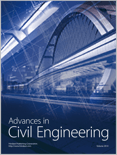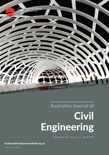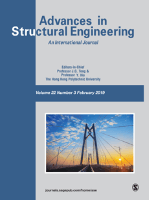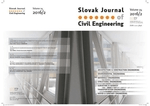
Civil Engineering Infrastructures Journal-CEIJ
Scope & Guideline
Building bridges between research and practice in civil engineering.
Introduction
Aims and Scopes
- Structural Analysis and Design:
The journal publishes research on the analysis and design of various structural systems, including reinforced concrete, steel structures, and innovative materials, addressing challenges such as seismic resilience and load-bearing capacity. - Materials Science in Civil Engineering:
CEIJ emphasizes the development and application of new materials, including sustainable concrete mixes, recycled materials, and advanced composites, to enhance structural performance and durability. - Geotechnical Engineering:
Research in this domain includes soil stabilization techniques, slope stability analysis, and foundation engineering, focusing on improving the reliability and safety of earthworks. - Transportation and Infrastructure Management:
The journal explores transportation engineering topics, including traffic flow analysis, infrastructure maintenance, and the impact of urban development on travel reliability and efficiency. - Environmental and Sustainability Issues:
CEIJ encourages studies that address environmental impacts and promote sustainable practices in civil engineering, such as the use of eco-friendly materials and waste management techniques. - Numerical Methods and Computational Techniques:
The journal highlights innovative computational methods for simulating and analyzing complex civil engineering problems, enhancing predictive capabilities and design optimization.
Trending and Emerging
- Sustainable Construction Practices:
Recent publications emphasize the use of sustainable materials and methods, such as geopolymer concrete and recycled materials, reflecting a growing commitment to environmentally friendly construction. - Smart Infrastructure and Technology Integration:
There is an increasing trend in research that incorporates smart technologies, such as Building Information Modeling (BIM), artificial intelligence, and machine learning, for enhancing infrastructure management and performance. - Resilience and Disaster Mitigation:
Emerging studies focus on improving the resilience of structures against natural disasters, particularly seismic and environmental impacts, indicating a heightened awareness of climate change and disaster preparedness. - Advanced Computational Techniques:
The adoption of advanced numerical methods, including finite element modeling and machine learning algorithms, for analyzing complex engineering problems is gaining momentum, showcasing the integration of technology in civil engineering research. - Health Monitoring of Structures:
Research on structural health monitoring and damage detection techniques is increasingly prevalent, highlighting the importance of maintaining infrastructure safety and longevity through innovative monitoring solutions.
Declining or Waning
- Traditional Materials Research:
There has been a noticeable decrease in studies focused solely on traditional materials without incorporating innovative or sustainable alternatives, as researchers are increasingly prioritizing advanced materials and sustainability. - Basic Theoretical Studies:
Papers that focus primarily on fundamental theoretical concepts without practical applications or advanced methodologies are becoming less common, as the journal seeks more applied and interdisciplinary research. - Conventional Geotechnical Methods:
Research centered exclusively on conventional geotechnical methods without the integration of modern technologies or sustainable practices is seeing a decline, as newer approaches gain traction. - Static Load Analysis:
The focus on static load analysis is diminishing in favor of dynamic analysis and performance-based design approaches, reflecting a shift towards understanding structures under variable and extreme conditions.
Similar Journals

Opir Materialiv i Teoria Sporud-Strength of Materials and Theory of Structures
Empowering Innovation in Construction and Material TechnologyOpir Materialiv i Teoria Sporud - Strength of Materials and Theory of Structures is a prestigious open-access journal published by BUDIVELNIK, focusing on significant developments in the fields of material science and structural engineering. Established in 2009, this journal facilitates the dissemination of original research articles, theoretical analyses, and case studies related to the strength of materials and structural stability. The journal aims to bridge the knowledge gap between academia and industry, fostering innovation and practical applications in construction and material technology. With its commitment to open access, Opir Materialiv i Teoria Sporud ensures that vital research is accessible to a global audience of researchers, professionals, and students, thereby contributing to the advancement of engineering practices and safety standards. The journal is based in Kyiv, Ukraine, and encourages rigorous academic discourse within its scope, making it an essential resource for those engaged in structural engineering and material sciences.

Magazine of Civil Engineering
Elevating Standards in Building and Construction ResearchMagazine of Civil Engineering, published by ST-PETERSBURG STATE POLYTECHNICAL UNIVERSITY, is a prominent open access journal dedicated to the field of civil and structural engineering. With an ISSN of 2712-8172 and E-ISSN 2071-0305, it serves as a vital platform for disseminating high-quality research, innovative methodologies, and current trends in building and construction. Since its inception in 2010, the journal has embraced open access, ensuring broad visibility and accessibility for its contributions to the academic community. The magazine holds a respectable position in the academic hierarchy, ranked in the Q3 quartile for both Building and Construction and Civil and Structural Engineering categories as of 2023. It is indexed in Scopus, amplifying its societal impact and reach with a rank of #114/223 in Building and Construction and #224/379 in Civil and Structural Engineering. Researchers, professionals, and students alike are encouraged to engage with the cutting-edge studies presented in the magazine, contributing to the advancement of knowledge and practice within the civil engineering domain.

CIVIL ENGINEERING
Innovating Civil Engineering for a Sustainable FutureCIVIL ENGINEERING is a prominent journal published by the American Society of Civil Engineers (ASCE), dedicated to advancing the field of civil engineering since its inception in 1969. With an ISSN of 0885-7024, this journal spans a wide range of topics, including civil and structural engineering, geotechnical engineering, and materials science, reflecting its comprehensive coverage of the discipline. Although currently categorized in the Q4 quartile for several fields, the journal provides a platform for researchers, professionals, and students to present innovative solutions and research findings that push the boundaries of civil engineering practices. While it does not offer open-access options, its accessibility through institutional subscriptions ensures that critical research remains within reach for those intent on furthering their understanding and applications in the field. Conference proceeding articles, case studies, and theoretical papers contribute to its mission of fostering communication and knowledge exchange among civil engineering practitioners and scholars. The journal's commitment to quality and relevance in today's evolving engineering landscape makes it an essential resource for informed decision-making and professional development.

Advances in Civil Engineering
Exploring New Frontiers in Civil EngineeringAdvances in Civil Engineering is a leading peer-reviewed journal published by HINDAWI LTD, dedicated to advancing knowledge and innovation in the field of civil and structural engineering. Holding an esteemed Q2 ranking in the 2023 category for Civil and Structural Engineering, this journal serves as a vital platform for disseminating cutting-edge research and practical applications that address contemporary challenges in infrastructure development, sustainable design, and material science. Launched in 2008 and operating as an Open Access journal since 2009, it promotes the free exchange of ideas by ensuring that all articles are accessible to researchers, professionals, and students globally. The journal is also indexed in Scopus, ranking at #142 out of 379 in its category, situating it within the 62nd percentile of its peers. With a focus on interdisciplinary collaboration and innovative solutions, Advances in Civil Engineering contributes significantly to the ongoing evolution of engineering practices and education, making it an essential resource for anyone involved in or studying the ever-evolving field of civil engineering.

Structure and Infrastructure Engineering
Advancing the Future of Engineering ExcellenceStructure and Infrastructure Engineering, published by TAYLOR & FRANCIS LTD, is a premier academic journal that serves as a vital resource in the fields of engineering and construction. Featuring an ISSN of 1573-2479 and an E-ISSN of 1744-8980, this journal has established its reputation as a leader in disseminating high-quality research. Since its inception, it has successfully transitioned through converged years from 2007 to 2024, earning a prestigious position within the Q1 quartile across multiple engineering disciplines, including Building and Construction, Civil and Structural Engineering, and Ocean Engineering, among others. Its impact is underscored by impressive Scopus rankings, particularly its 5th rank in Ocean Engineering within the top 95th percentile. The journal’s commitment to advancing knowledge in safety, risk, reliability, and quality makes it an indispensable platform for researchers, professionals, and students aiming to stay at the forefront of engineering innovations. Access to its comprehensive articles allows for a deeper understanding of contemporary challenges and solutions in infrastructure development.

Australian Journal of Civil Engineering
Innovating Infrastructure for TomorrowThe Australian Journal of Civil Engineering, published by Taylor & Francis Ltd, stands as a pivotal platform within the field of civil and structural engineering. With an ISSN of 1448-8353 and an E-ISSN of 2204-2245, this journal consistently delivers high-quality research and innovative practices from both established and emerging scholars in the discipline. Recognized in the Q2 category for Civil and Structural Engineering in 2023, it holds a respectable position, ranking 146 out of 379 within its field according to Scopus, which places it in the 61st percentile. Converging valuable insights from 2011 through 2024, the journal encompasses a broad scope of topics, including sustainable infrastructure, innovative materials, and advanced construction techniques, thereby addressing contemporary challenges faced by engineering professionals. Though it is a traditional publication without open access options, the quality of the research featured ensures that it remains an essential resource for academics, practitioners, and students striving to enhance their knowledge and contribute to the dynamic field of civil engineering.

Infrastructures
Innovating Infrastructure Solutions for a Sustainable FutureInfrastructures is a distinguished open-access journal, published by MDPI since 2016, dedicated to advancing the fields of engineering and construction through interdisciplinary research and critical insights. Based in Switzerland, it serves a global community of scholars and professionals, providing a platform for innovative studies that drive progress in Building and Construction, Civil and Structural Engineering, Computer Science Applications, Geotechnical Engineering and Engineering Geology, and various aspects of Materials Science. With an impressive impact factor and a positioning in the Q2 category across multiple engineering fields, the journal's robust ranking reflects its commitment to high-quality research, with notable Scopus rankings showcasing its significant contribution to academic discourse. Infrastructures not only facilitates open access to essential knowledge but also aims to bridge the gap between theory and practical application, making it an invaluable resource for researchers, industry professionals, and students alike.

ADVANCES IN STRUCTURAL ENGINEERING
Bridging Theory and Practice in Structural EngineeringADVANCES IN STRUCTURAL ENGINEERING, published by SAGE PUBLICATIONS INC, is a leading journal dedicated to the advancement of knowledge in the fields of Building and Construction, as well as Civil and Structural Engineering. With a solid impact factor and a commendable Scopus ranking (Rank #60 in Building and Construction, Rank #105 in Civil and Structural Engineering), this journal stands at the forefront of academic research, providing a platform for high-quality articles that contribute significantly to the discipline. Covering a range of topics from innovative construction techniques to sustainable engineering practices, the journal aims to foster collaborative dialogue among researchers, industry professionals, and students alike. As of 2023, it boasts impressive category quartiles, ranking Q1 in Building and Construction and Q2 in Civil and Structural Engineering. ADVANCES IN STRUCTURAL ENGINEERING is a vital resource for those looking to stay abreast of emerging trends and groundbreaking developments in structural engineering, promoting an environment of continuous learning and application of best practices. With a convergence of research from 1999 to 2024, the journal not only emphasizes theoretical frameworks but also bridges the gap between academia and practical application in engineering projects.

Journal of the Korean Geosynthetic Society
Pioneering Research in Geosynthetics and Environmental SolutionsJournal of the Korean Geosynthetic Society, published by the Korean Geosynthetic Society, is an essential platform dedicated to advancing the field of geosynthetics, a critical area of civil engineering and environmental science. With a focus on innovative materials and applications that contribute to sustainable infrastructure and environmental protection, this journal actively encourages submissions from researchers and practitioners worldwide. Although currently not indexed by Impact Factor systems, the journal's commitment to rigorous peer-review ensures the dissemination of high-quality research and practical insights that drive the field forward. The journal publishes a range of articles including experimental studies, theoretical analyses, and case studies, making it a valuable resource for engineers, researchers, and students alike, fostering collaboration and knowledge sharing within the geosynthetic community. The journal is accessible at http://www.kgs.org. Join us in shaping the future of geosynthetic technology through your contributions!

Slovak Journal of Civil Engineering
Fostering collaboration for a sustainable engineering future.Welcome to the Slovak Journal of Civil Engineering, a premier open-access publication dedicated to advancing the field of civil engineering. Published by SCIENDO, this journal has been providing a platform for the dissemination of groundbreaking research since 2010, ensuring that all articles are freely accessible to a global audience. With a commitment to promoting innovation and excellence within civil engineering, the journal covers a wide range of topics, including structural engineering, transportation systems, geotechnics, and environmental engineering. The Slovak Journal of Civil Engineering is designed to engage a diverse community of researchers, professionals, and students, fostering collaboration and knowledge-sharing to address contemporary challenges in the field. With its open-access model, the journal not only enhances visibility for authors but also ensures that the latest findings and methodologies reach practitioners and academics alike, making it an essential resource for anyone interested in civil engineering advancements. Stay connected with the evolving landscape of civil engineering through this influential publication.